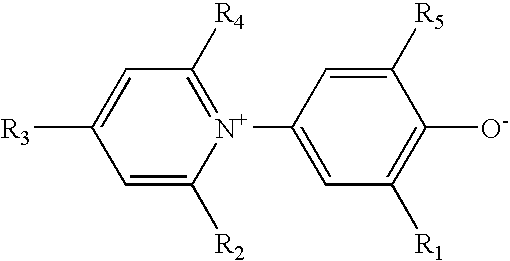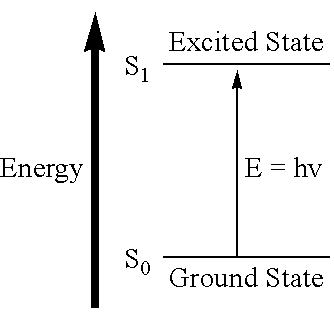Microbe-sensitive indicators and use of the same
- Summary
- Abstract
- Description
- Claims
- Application Information
AI Technical Summary
Benefits of technology
Problems solved by technology
Method used
Image
Examples
example 1
[0085]The use of chameleon type microbe-sensitive dyes to display signal graphics was demonstrated as follows. A CCI Multigloss yellow base pigment (available from Color Converting, Inc. of Hazleton, Pa.) was applied to a white SMS (spunbond / meltblown / spunbond) nonwoven material (available from Kimberly-Clark Corporation of Irving, Tex.) using a standard hand roller. The treated nonwoven was oven-dried at 100° C. for approximately five minutes. A solution of Reichardt's dye was prepared by mixing about 200 mg of Reichardt's dye (obtained from Sigma-Aldrich of St. Louis, Mo.) with approximately 5 g of octanol (obtained from Sigma-Aldrich). This solution was then applied in the shape of a “t” to the dried yellow pigment on the nonwoven material using a clean hand roller. A control material was prepared by applying the Reichardt's dye / octanol mixture in the “t” pattern to a sheet of untreated white SMS nonwoven material. The samples were again oven-dried at 100° C. for approximately fi...
example 2
[0086]This experiment illustrated the ability of a surface coating of Reichardt's dye to respond to bacterial contamination. A sheet of paper was brush-coated with a Reichardt's dye solution (80 mg / 10 mL acetonitrile). To this paper was added 100 μL aliquots of 107, 106, 105, and 104CFU / mL E. coli (ATCC #8739) or S. aureus (ATCC #6538) solutions. Water was used as a negative control. The dye color was rapidly discharged when contaminated by both types of bacteria, but more rapidly for the S. aureus. It was later determined that while both bacteria solutions were indeed at 107 CFU / mL concentrations, the actual concentration of the S. aureus solution was 7×107 CFU / mL compared to 1×107 CFU / mL for the E. coli solution. Water caused slight de-colorization of the dye after several minutes, in contrast to the rapid de-colorization (<1 min) observed for the bacteria solutions.
[0087]A sheet of paper self-adhesive stickers (Avery-Dennison) was also brush-coated with two different concentratio...
example 3
[0088]This experiment illustrated the ability of a strong base to reverse decolorization of Reichardt's dye. Several drops of Reichardt's dye (160 mg in 10 ml of acetonitrile) were pipetted onto a SCOTT® towel and allowed to dry. Two compounds known to cause color changes (acetic acid and Aldrich buffer pH 2.0) were each dropped onto two of the spots which led to rapid de-colorization of the dye. A drop of 1 N NaOH was then pipette onto one of each of the spots, causing rapid re-colorization. The blue / purple color of Reichardt's dye returned after the 1 N NaOH was added.
PUM
| Property | Measurement | Unit |
|---|---|---|
| Time | aaaaa | aaaaa |
| Color | aaaaa | aaaaa |
| Transparency | aaaaa | aaaaa |
Abstract
Description
Claims
Application Information
 Login to View More
Login to View More - R&D
- Intellectual Property
- Life Sciences
- Materials
- Tech Scout
- Unparalleled Data Quality
- Higher Quality Content
- 60% Fewer Hallucinations
Browse by: Latest US Patents, China's latest patents, Technical Efficacy Thesaurus, Application Domain, Technology Topic, Popular Technical Reports.
© 2025 PatSnap. All rights reserved.Legal|Privacy policy|Modern Slavery Act Transparency Statement|Sitemap|About US| Contact US: help@patsnap.com



